Mactier Surname Ancestry ResultsOur indexes 1845-1865 include entries for the spelling 'mactier'. In the period you have requested, we have the following 12 records (displaying 1 to 10): Buy all | | | Get all 12 records to view, to save and print for £60.00 |
These sample scans are from the original record. You will get scans of the full pages or articles where the surname you searched for has been found. Your web browser may prevent the sample windows from opening; in this case please change your browser settings to allow pop-up windows from this site. Britiish officers wounded at Moodkee
(1845)
Two key battles in the destruction of the Sikh army prior to annexation of the Punjab by the British army of the Sutlege (Sutlej) under His Excellency Sir Hugh Gough took place at Moodkee on 18 December and Ferozeshuhur (Ferozeshaah) 21 and 22 December 1845. This is the official return of the British officers killed and wounded in the two engagements: the bulk of losses were to Her Majesty's 9th, 31st, 50th, 62nd and 80th Regiments of Foot, the 3rd Light Dragoons, 42nd Light Infantry, the 1st European Light Infantry, the 12th and 14th Native Infantry, and the artillery.MACTIER. Cost: £6.00.  | Sample scan, click to enlarge

| Graduates of Cambridge University
(1760-1846)
Joseph Romilly, registrar of the university of Cambridge, compiled Graduati Cantabrigienses, a catalogue of graduates from the academic year of admissions 1760 through to 10 October 1846. The names are arranged alphabetically by surname, and then chronologically by christian name: the college is given, with an asterisk in those cases where the man became a fellow, and then, in chronological order, his degrees. MACTIER. Cost: £4.00.  | Sample scan, click to enlarge
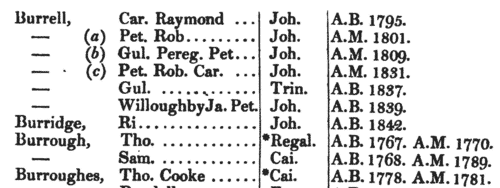
| The Edinburgh Gazette
(1846)
The Edinburgh Gazette is the official publication in which various Scottish legal notices are issued, as well as promotions and casualty lists for the British army as a whole, and brief lists of English bankrupts. The key source for tracing details of Scottish bankruptcies, insolvencies, and dissolutions of business partnerships.MACTIER. Cost: £6.00.  | Sample scan, click to enlarge
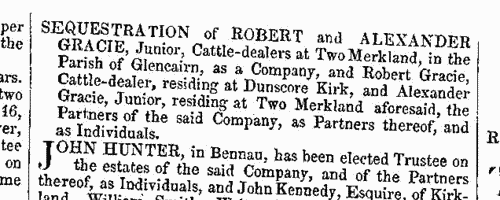
| British Army officers in the annexation of the Punjab
(1845-1849)
By 1845 the Sikh state of Lahore was the remaining substantial military power in the Indian sub-continent outside British rule. Its khalsa army was well equipped, disciplined, tenacious and had three European officers among its commanders. The sikhs controlled not only the Punjab, but Pathan tribes as far as the border with Afghanistan, and the whole of Kashmir. The river Sutlej formed the boundary between the Sikh state and British India. In early December 1845 the Sikh army crossed the Sutlej and invested the British garrisons at Ferozepore; 13 December 1845 the British declared war. After defeat in a series of battles, at Moodkee (18-21 December), Ferozeshah (21-22 December); Budhowal and Aliwal (23 December, 28 January); and Sobraon (10 February 1846), the state of Lahore submitted to the Treaty of Lahore, ceding the Punjab between the Sutlej and the Beas, Kashmir, and paying half a crore of rupees. The state of Lahore itself continued under the durbar as a British protectorate during the minority of the young maharajah; and the Sikh army was put under British command. Kashmir was sold by the British to the ruler of Jammu for a crore, and the submission of Kashmir to Jammu was effected by a Sikh force under British officers. British garrisons were placed in the Punjab, but the fort at Multan refused to submit, and had to be besieged. During the siege a Sikh regiment defected to join other khalsa remnants, in defiance of the durbar at Lahore, and raised a rebellion (August 1848 to January 1849). Battles at Chillianwalla (13 January 1849) and Gujerat (21 February 1849) destroyed the Sikh army. The British then annexed the whole of the Punjab, incorporating it into British India. This account of the Annexation of Punjab by Arthur D. Innes and General Charles Gough was published in 1897, but with a poor index; we have remedied that. The account also includes a description of the battles of Maharajapore and Puniar (29 December 1843) by which the army of Gwalior was destroyed. MACTIER. Cost: £6.00.  | Sample scan, click to enlarge
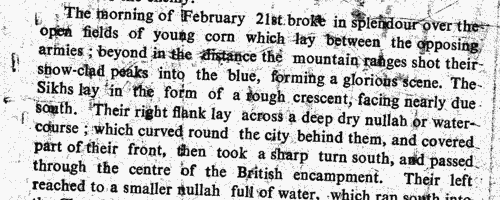
| British Army Officers
(1853)
The 14th volume of the New Annual Army List, for 1853, corrected to 30 December 1852, was published by Major H. G. Hart of the 49th Regiment. It contained 'the dates of commissions, and a statement of the war services and wounds of nearly every officer in the Army, Ordnance and Marines'. The first section, pages 1 to 111, lists officers of the rank of major and above in order of rank and precedence; officers with local rank (112-114); Yeomen of the Guard (115); the Honourable Corps of Gentlemen-at-Arms (116); Headquarters Staff (117); and then (as in the scan) all the regiments and units in order of precedence, giving any regimental honours, with all the officers by rank, and details of postings, facings and agents (118-336). A long section (337-426) then lists officers on the retired full pay and half-pay, including the Royal Regiment of Artillery, Corps of Royal Engineers, Royal Marines and military departments. Then there are lists of officers in the Commissariat Department, the Medical Department, Veterinary Surgeons and the Chaplains Department. A section of Officers on the Foreign Half-Pay gives lists for the German Legion and Miscellaneous Corps (Brunswick Cavalry, Brunswick Infantry, Chasseurs Britanniques, Royal Corsican Rangers, Dillon's Regiment, Greek Light Infantry, Royal Malta Regiment, Meuron's Regiment, Roll's Regiment, Sicilian Regiment, Watteville's Regiment, York Light Infantry Volunteers, the Foreign Veteran Battalion, and the Foreign Corps of Waggoners). After lists of officers in garrisons and military establishments, there are sections listing officers holding Gold Decorations for their parts in various important actions and other British decorations, and those holding medals bestowed by foreign powers. MACTIER. Cost: £4.00.  | Sample scan, click to enlarge
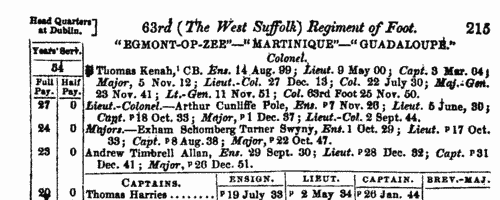
| Deaths, Marriages, News and Promotions
(1854)
Death notices and obituaries, marriage and birth notices, civil and military promotions, clerical preferments and domestic occurrences, as reported in the Gentleman's Magazine. Mostly from England and Wales, but items from Ireland, Scotland and abroad. July to December 1854
MACTIER. Cost: £4.00.  | Sample scan, click to enlarge
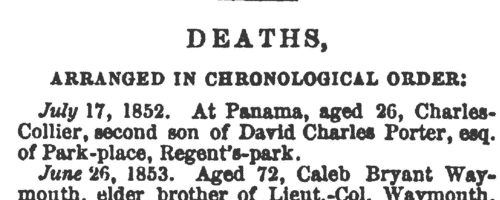
| Deaths, Marriages, News and Promotions
(1856)
Death notices and obituaries, marriage and birth notices, civil and military promotions, clerical preferments and domestic occurrences, as reported in the Gentleman's Magazine. Mostly from England and Wales, but items from Ireland, Scotland and abroad. January to June 1856
MACTIER. Cost: £4.00.  | Sample scan, click to enlarge

| Bengal Civil Servants: Third Class
(1857)
The East India Register and Army List was compiled, by permission of the East India Company, from the official returns received at the East India House. The list of civil servants in Bengal presidency is arranged by class of rank, and then by seniority of appointment. The season of appointment is given on the left, then name (usually in the form christian name, initials for middle names, surname) and current position, or if on furlough - except in the case of the appointees of the season of 1856 in the sixth class, where no position is stated, and christian names are given only as initials.MACTIER. Cost: £6.00.  | Sample scan, click to enlarge

| Calcutta Death Notices
(1857)
A compilation of death notices from Calcutta newspapers published in England in the Indian Mail in 1857, and covering the period 21 October 1856 to 7 November 1857. Most, but not all, of the deaths recorded happened within the Bengal presidency.MACTIER. Cost: £6.00.  | Sample scan, click to enlarge

| Casualties by Death in the Armies of India: Bengal
(1857)
Each issue of Allen's Indian Mail carried summary lists of 'Casualties by Death in the Armies of India reported since our last Publication', divided into the Bengal, Madras and Bombay presidencies, and Her Majesty's Forces in the East. Most of the deaths reported took place in India, but there are some from England, and among British troops campaigning in Persia and China, and elsewhere. These deaths reported in 1857 include some as far back as November 1856.MACTIER. Cost: £6.00.  | Sample scan, click to enlarge

|
| 1 | 2 |  |
Research your ancestry, family history, genealogy and one-name study by direct access to original records and archives indexed by surname.
|












